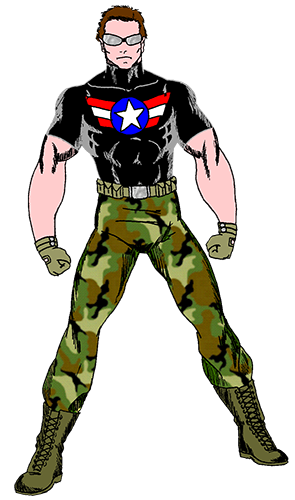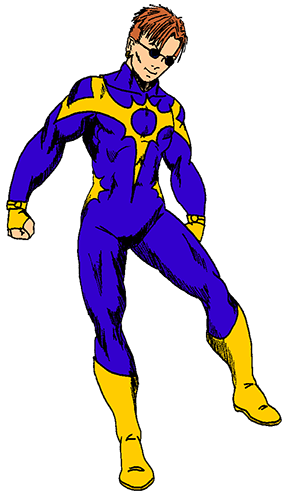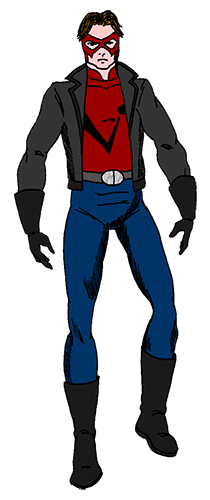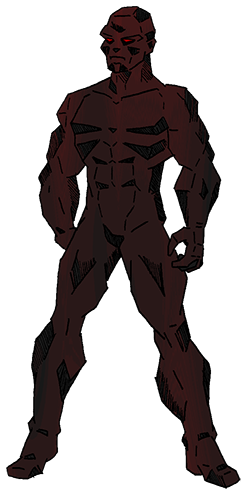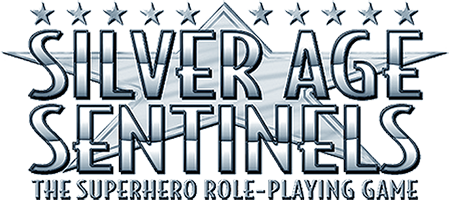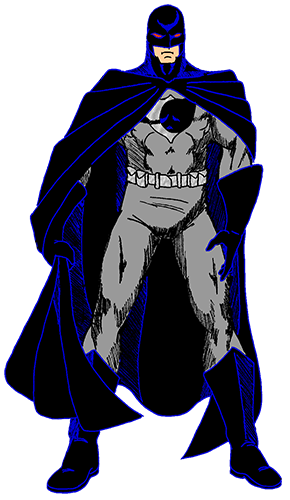
KNIGHTSHADE
Personal Information
- Alter Ego: Christopher Trent
- Occupation: CEO of Trent Media Corporation
History
Christopher Trent was the second son of media baron Robert Preston Trent III. His older half-brother, Robert "Bobby" Trent IV, was the child of the elder Trent's and his first wife, a Hollywood starlet who had died of a drug overdose when Bobby was six. Christopher's mother was a member of the Spanish aristocracy, a distant relative of the Royal Family from a branch that had fallen on hard financial times. Robert had not wanted another child, but his new wife did and he could refuse her. Even so, the elder Robert did not care for his new son, preferring his namesake and likely successor. When he was twelve years old Christopher was kidnapped and held for over a month before his mother finally paid the ransom, though Christopher never learned where she got the money as it had definitely not come from his father. Disgusted with what Robert had allowed to happen, Christopher's mother took him to Europe, ostensibly to give the child time to recover from the trauma, but in reality she was done with her husband and wanted to raise their son away from his toxic presence.
After the kidnapping, Christopher became a more focused child. Before this the combination of his father's neglect and mother's indulgence, he had flown from one hobby to another; sports, acting, music, writing, he had tried his hand at them all. Now, while his interests were no less diverse, Christopher dedicated himself to each, searching for something he could not yet identify. At age 18 Christopher left his mother's side for the first time since the kidnapping and journeyed eastward. Over the next several years he traveled through the Middle East and on to the Far East, continuing his studies. He learned survival skills from Bedouin tribesmen and meditation and philosophy from Tibetan monks; honed his body and mind in one of the last true Shaolin temples in China; hunted rebel terrorists in the jungles of Southeast Asia alongside Special Forces mercenaries; and learned to hack computers from a cyber master in a small room above the Akihabara district in Tokyo.
He had been on this quest for nearly a decade when Christopher heard the news; something had happened back in America. He was trekking the Australian Outback at the time, so a small bush plane was dispatched to fly him to Sydney where a team of lawyers informed him that his older brother was dead and his father was in a coma. He flew with the lawyers back to New York City, where he was surprised to find his mother. Christopher learned the details of what had happened, both what was being reported in the media and the reality. His brother had been killed in a car crash, the toxicology report showing he was high on crack cocaine at the time having been quietly buried; and his father's coma was the result of a stroke, the media reports discretely ignoring the alcoholic binge that had induced the stroke in the wake of him hearing the news of his oldest son's death.
Christopher had another surprise coming; that he was now in charge of my father's media empire. The lawyers told him that his father had left instructions that should he ever be incapacitated, either physically or mentally, and be unable to fulfill his duties as chairman of the company that his son was to take his place. The document did not specify which son, however, though it was understood that Chritohpher's father had meant his brother; but Bobby was dead and so the post was now Christopher's. Despite his mother urging him to reject the position and come back to Europe with her, Christopher decided he would accept it. Though his mother's offer had been tempting, something stopped him from taking it. Christopher had searched the world over for an answer to a question he did not know and found nothing, so perhaps the answer was here, where the search had begun so many years earlier.
Uncomfortable living on the family estate, Christopher instead moved into a Manhattan penthouse. He slowly immersed himself into his new role, learning just how vast his father's empire was. It was not just the television networks and newspapers and magazines; there was a movie studio, Internet providers, telecommunication and cellular providers, a software company, and dozens of other small enterprises. New York's elite welcomed him into their ranks and an adolescence spent with his mother amongst European high society enabled him to blend in seamlessly despite his personal misgivings. Christopher also had years of watching his father to show him how to display a public persona far different from one's true face. Soon he was acclimated enough to his new rank and position to turn his focus onto the Trent media empire in earnest. Not long after this the nightmares began.
The Trent media empire was concerned with information, but the ultimate motivation was always profit. The news stories and magazine articles had subject matter determined by which would generate higher ratings or better sales, not by the merit of the subject, and one thing became clear to Christopher: misery sells. Stories of crime and corruption dominated the headlines of his father's papers; his news networks led with stories of murders and assaults. Everywhere Christopher looked the faces of the victims stared back at him, even in his dreams. Unable to sleep, he took to wandering the city at night incognito.
Everything seemed more alive to Christopher at night, though at the time he did not know why. As the nights progressed he felt closer to his unknown goal, and his anticipation seemed to build with each successive excursion. Finally, something happened. It was early fall and New York was being buffeted by the remnants of a tropical storm that had wreaked havoc along the gulf coast earlier that week. Torrents of rain poured down and Christopher found himself seeking shelter in a nearby late-night convenience store. It turned out there were others who had sought out the store that night, but for very different reasons. Two masked men with guns were holding the store's few patrons hostage while a third was watching as the clerk emptied the contents of the register into a duffel bag; Christopher was ordered to join the other hostages. Just then the lights went out, a result of power lines being knocked down by the storm. Reflexes honed in the mountains and jungles of Asia took control and Christopher leapt into action. When the lights came back on seconds later the three gunmen were unconscious and Christopher was gone.
Christopher woke up the next morning and realized that his sleep, for the first time in weeks, had not been interrupted by nightmares. He looked through the morning papers, searching for news of what had happened. The article was buried in the middle of the City section, “Mystery Man Foils Robbery”. Among the photos accompanying it was a grainy security camera shot of Christopher, a barely discernible figure in a dark, rain-drenched hooded sweater. More importantly than this photo, however, was the photo of the clerk and the store patrons. Christopher realized then that had he not been there this would have been another photo of victims. But he had been there, he had stopped the robbery, and these faces would not be haunting his dreams.
Most people had assumed that Christopher's determined adolescent studies and his later travels had been about learning to protect himself. The reality was that his life had been a quest in search of an unknown goal. After the previous night's events he now knew that all his efforts had been to prepare himself for that, the moment when Christopher found his true self. He had perfected my body, mind, and spirit and now he would direct that power to this new purpose. Christopher's dreams had been trying to tell him the truth for weeks, that there were countless innocent victims in the world with no one to fight for them, no one to protect them. Chrstopher would become that fighter, that protector, a force for justice with a truly worthy quest, to make the world a place where no one need be a victim again. This revelation had not come to Christopher in a brilliant flash of light or in a shining moment of inspiration, it had come to him in the dark.
The revelation reminded Christopher of a lesson learned years earlier, one he had not been aware of for some time but that he now saw was always there beneath the surface. He had never told anyone what had really happened to him when he was kidnapped as a boy, never gave the details of his ordeal. Christopher's captors had kept him locked in the sub-basement of an abandoned factory. There was no light except around the seam of the door and the small hatch that they sent his food through, and then only when his captors were present in the adjoining room. His senses became honed during that month of captivity, hearing and touch compensating for sight. The kidnappers would occasionally come into his prison to ask him questions, or just to beat him. Christopher knew fear, but he never once knew despair.
Even as a child Christopher possessed a strong will and remarkable spirit, something inherited from both my parents he suspected. Throughout his torment he had stood strong. He even tried to escape once. Each time his captors had come Christopher would be blinded by the light streaming in from the next room. One day, almost three weeks into his captivity, he came up with a plan. Christopher worked a metal pipe loose from its fixture on the wall for a weapon and tore off part of his shirt. He wrapped the torn cloth around his eyes to shield them from the light and waited. This time when the kidnappers entered Christopher's cell he struck. He managed to injure two of them before the others restrained him. The beatings increased in frequency and severity after that and Christopher came to trust the dark of his cell. Darkness was my friend. After his release Christopher was brought back into the light and, at least consciously, forgot what he had learned about light and dark. That night, in the convenience store, in the dark faced with enemies, Christopher remembered: trust the dark, the dark is your friend.
Following the example of costumed vigilantes, Christopher created an alter ego of his own. His family's wealth let him acquire cutting edge equipment, and Christopher set out to show the criminals of New York City the truth: they may act in the dark because they believe it conceals, but they were wrong, the darkness hides nothing from Christopher. The thieves and drug dealers and rapists and murderers of the city would soon learn that there are very good reasons to be afraid of the dark. For a time Christopher's alter ego would simply be known as The Dark, a nod to his crusade, but when he began operating more openly, he would need a more proper identity. As such, when he began working with the Sentinels he took on the codename Knightshade.
Skills & Equipment
Years of training has made Knightshade an expert in a variety of martial arts, both armed and unarmed. He also has learned how to track and shadow targets, moving with a level of stealth that borders on invisibility. Knightshade is also highly perceptive and has become a skilled investigator. When in action he wears a padded costume that provides sufficient armor to protect him from small-arms fire. He also carries a variety of offensive weapons, including throwing blades as well as blunt throwing weapons, a collapsible combat baton. Knightshade also has a range of high-tech equipment like a multi-spectrum flashlight, a portable crime kit, grappling lines, nightvision lenses, and other items as the situation requires.
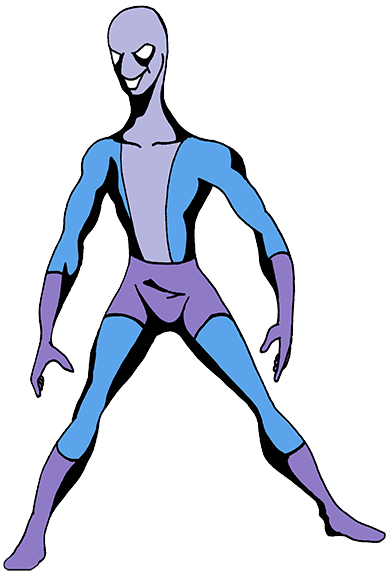
CHANGELING
Personal Information
- Alter Ego: "Junior"
- Occupation: none
History
In the far reaches of the galaxy lies the space controlled by a vicious race of alien invaders. Their campaigns of conquest always follow the same pattern. First the scouts come to covertly observe the target planet and determine if it is worth conquering. If conditions are favorable for invasion, the scouts will leave behind one or more infiltration units. These bio-engineered constructs will be programmed to infiltrate and observe, remaining undetected while reporting back their findings to the scouts, who then pass it back to their military masters. Slowly the infiltration units earn positions of trust and respect in important government, military and civilian organizations. Then, when the time of the invasion arrives the infiltration units strike, crippling the planetary defenses and spreading chaos, facilitating the invasion force's strike.
In the middle of the 20th century a scout ship came to Earth, and promptly crashed. The US government seized the wreckage and covered up the crash. Among the recovered debris was a mysterious, two-foot long silver egg. The government agents did not know it, but they had recovered one of the infiltration units, one that had not yet been programmed for its mission. The egg, along with the rest of the wreckage was taken to a top-secret military base in the Southwest US for study.
Government scientists began studying the egg, scanning it with x-rays and other means to try and discover what was inside. When these efforts failed, the scientists tried to open the egg manually. When the first scientist touched the egg it opened on its own and a strange, silver-gray liquid oozed out. Almost immediately the liquid assumed a human shape, the size of a child, and it bore a slight resemblance to the scientist that had touched the egg. The new life form that had emerged was aware, but did not seem to be intelligent. Some of the scientists assumed it to be some kind of alien infant. The entire lab was immediately isolated as fierce debate raged over what to do with the alien life form. Several of the scientists wanted to try and educate the alien, others wanted to dissect it for study, while several of the more militant officers simply wanted the thing destroyed.
Eventually a compromise was reached and a new ultra-secret lab was established in New Jersey, one dedicated to the study of the life form. There was to be no further direct contact with the life form after its reaction to the scientist so an isolated environment was set up. To interact with the life form, sophisticated (for that era) animatronic robots were built (with the unwitting help of theme park engineers). These robots acted as parent and teacher to the life form. While the life form reacted to the robots, its development seemed to be stalled. Finally it was discovered that the life form reacted positively to audio-visual recordings. To facilitate development, the life form's habitat was equipped with a television. Once it was exposed to television, the life form's speech communication ability quickly developed and it was able to interact verbally with the observing scientists (through the robot "family").
Children's programming proved extremely effective in encouraging the life form's development, especially Sesame Street. The scientists always knew the life form could change its form, but its incredible versatility became apparent as it began imitating the myriad shapes it saw on the show, from simple objects through more complex polygonal figures. Once its shape-shifting powers became apparent, the life form drew the attention of a different group of observers. A super secret intelligence agency now became involved in the examination of the life form. Their goal was to try and turn the life form into the ultimate Cold War spy and assassin; little knowing that this was very close to the life form's original purpose.
The intelligence agents tried to train the life form to impersonate important Communist officials. They began teaching it Russian and trying to get it to assume the form of people they wanted impersonated. The agents tried for years, but even though this was exactly what the life form was designed for, the methods the agents were using were not how the infiltration unit was supposed to be programmed. While it easily learned Russian, it could not accurately duplicate the appearance (or voice) of the desired target. Little could the agents know that the life form needed personal contact to properly duplicate people and objects. The two-dimensional pictures the agents were using were insufficient for the life form to duplicate the target. As eager as the life form was to try and do what was asked of it, the agents were consistently disappointed.
Eventually the repeated failures of the intelligence agency to turn the life form into a weapon caused the funding to be pulled. The scientists went back to trying to understand the life form, but they continually failed to realize that simple direct contact was the key for the life form to continue its maturation. In the end television was the only thing that seemed to have any effect, especially cartoons and other children's programming. As the years passed more and more funding was pulled and there were fewer and fewer staff assigned. After decades the facility was largely forgotten except for a handful of scientists and maintenance engineers. As automation advanced, the staff levels were reduced fewer as the lab became self-sustaining. Eventually only a single, aged scientist remained, the very one who had been there when the life form "hatched" decades earlier. Then one day this old man suffered a fatal heart attack, collapsing in the monitoring room. By then the facility was largely forgotten and nearly completely automated. Even the life form was unaware that it was now alone, only noticing the change in the voice from its robot family (the scientist would occasionally speak through the robots). The life form continued its routine, days filled with watching television, eating the organic paste the robots brought to it, and answering computer-generated questionnaires designed to test and expand its knowledge.
After many years the facility, buried deep beneath a forgotten building in New Jersey, began to break down. Finally, maybe due to a natural disaster, or maybe the result of collateral damage from some super-villain battle, the lab broke down. The robots stopped working, the food stopped coming and, most importantly, the television stopped working. After waiting and waiting with no TV and no food, the life form finally decided to leave. It wandered for hours through the dark, not even noticing the decaying corpse in the control room. Finally the life form emerged into the bright (smoggy) light of the New Jersey sky.
After decades of limited physical contact each sensation was new and filled with wonder. Wandering for several days, the life form was hopelessly lost, unable to find its way back to the lab. Then the life form stumbled across a warehouse fire, and decided that, like the heroes in the television shows it had been raised on, it would try and help. Adopting what it thought was a heroic enough looking form, the life form helped rescue people from the fire and attempted to battle the blaze. The heroic Sentinels team also arrived on the scene and together they ended the danger. The life form was taken in by the team and it joined the Sentinels, taking the heroic name Changeling.
Powers & Abilities
Changeling is a shapeshifter, able to alter his form to a radical degree. He can adopt nearly any humanoid form, though duplicating an individual usually requires physical contact. He can stretch his limbs and grow or shrink, though not to an excessive degree. Changeling's metamorphic abilities were versatile enough that he could even harness his internal energies to replicate the effects of a variety of super powers. As he progressed in his new role as super-hero, Changeling came to adopt some default forms; one was designed for flexibility, where he would twitch and shape his limbs and size, and the other was a more traditional super-hero form where he had superhuman strength, resistance to injury and even the ability to fly.
With no proper imprinting or programming at the time of his “birth”, and no direct human contact after, Changeling's personality was directly influenced by television; years and years and years of American television programming. Children's programming was the largest influence, mainly because it was the most simple, dynamic and entertaining so it was what he watched most. Because of this Changeling was effectively a child when he first joined the Sentinels. He was intelligent, and relatively knowledgeable, but immature. The more he was exposed to real people though, the more he began to mature.
The SENTINELS
The Sentinels was, unsurprisingly, the name given to the primary hero team in Silver Age Sentinels. In this campaign the player character heroes were the latest iteration of this team. While based in New York City, the team engaged in adventures across the world. Some of the other characters in the campaign were:
- Fenian: legacy hero from Boston
- Nova: cocky energy projector
- Ricochet: kinetic controller
- Obsidian: rocky brick
